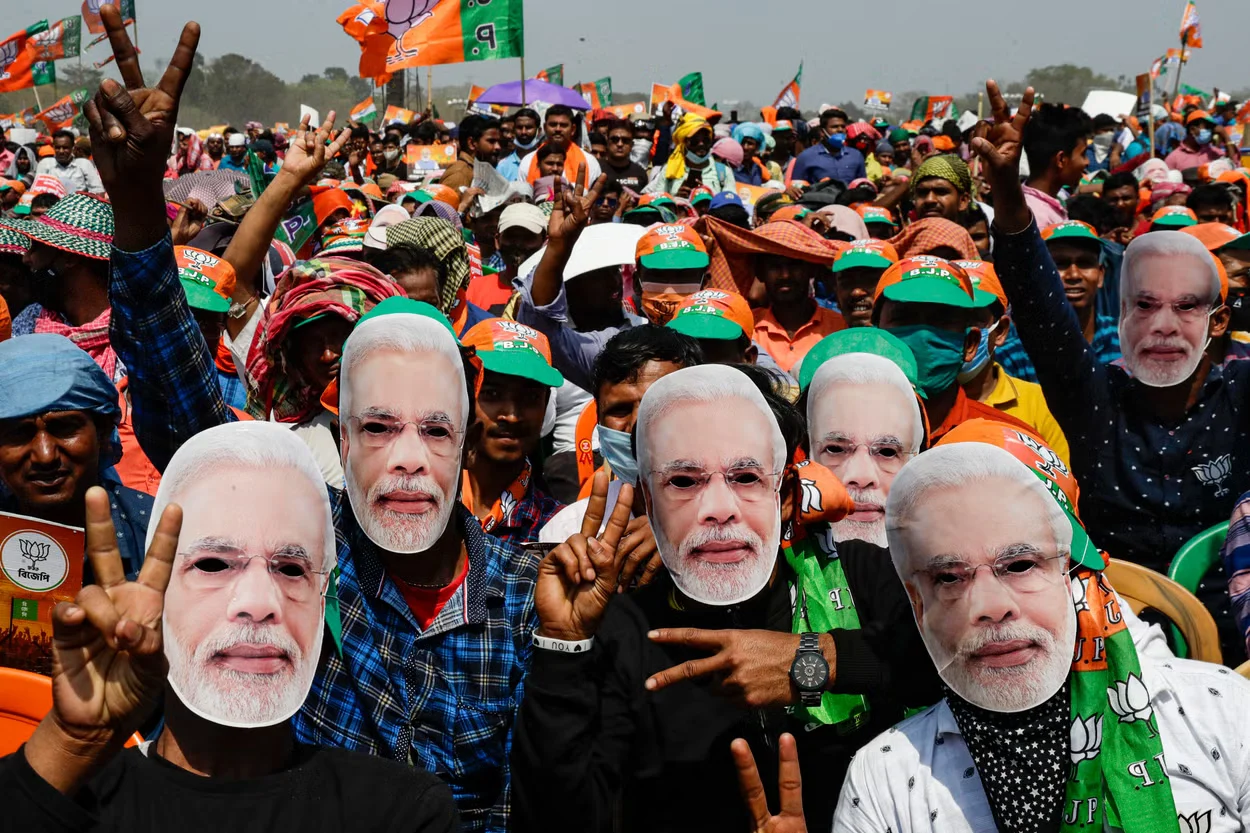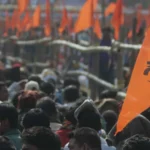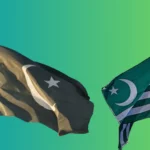A god has taken possession of the Germans and their house is filled with a mighty, rushing wind. A hurricane has broken loose in Germany while we still believe it’s fine weather.
Carl Jung, 1936
Uttar Pradesh – the largest global administrative unit, the largest state of the most populous “democracy” in the world, home to the ancient sagas of the Ramayana and the Mahabharata through the cities of Ayodhya and Mithra, cradle to the Mughal chapter of Indian and Islamic civilizations, where the Ganges, Jamuna and the mythical Sarasvati flow, and where more than 200 million people live. It is hard to over-emphasize the importance of Uttar Pradesh (UP) inside the Indian polity. No wonder 9 out of 15 Indian Prime Ministers came from UP. No wonder elections in UP are considered second only to the nationwide Indian General Elections.
On 10th March the results of five state elections in India were declared. 4 out of those 5 (UP, Uttarakhand, Goa, and Manipur) brought victory for the BJP of Narendra Modi. The sole exception turned out to be the Sikh-majority state of Punjab. But the focus here is more on UP. After all, it is this state where the political pulse of India can be most accurately measured. First, look at some numbers. Out of 403 seats, the BJP won 255 (its allies won a further 18). But, the BJP had won 312 seats in 2017. So, can we say that the tide of Hindutva craziness is receding and BJP’s star is on the wane?
Well, why not dig into the numbers a bit more before a celebratory dance. If we look at the votes received by BJP, at 41.29%, it’s the highest-ever percentage secured by it in UP. In 2017, BJP received 39.6% votes. So, now it is clear that BJP’s popularity in UP has actually increased. Now, it is apt that we discuss the reasons for BJP’s loss of seats despite increased popularity.
In UP, aside from BJP, the Samajwadi Party (SP), the Bahujan Samaj Party (BSP), and the Indian National Congress (INC) are thought of as major political players. The INC ruled the roost in UP up till the 1980s but it has mostly ceased to exist as a sizable political force here (receiving 6% and 2% votes in 2017 and 2022 respectively). That leaves the SP and the BSP. Both are caste-based parties and both vie for the “Muslim vote”. But where the SP is a party representing the aspirations of the castes like Yadavs (belonging to the “Other Backward Classes” category or OBCs.
Their rank is lower than higher castes like Brahmins in the Hindu social structure but higher than the Scheduled Castes or Dalits), the BSP is a party primarily representing the Dalits. If we look at the numbers, it turns out that the SP has gained almost exclusively at the expense of BSP. In 2017, the SP and BSP had secured about 22% votes each, winning 47 and 19 seats respectively. This time, the SP has taken 32% votes to the BSP’s 13%.
To analyze further we need to answer the question, “Who are these 10% voters who have shifted from the BSP to SP?” It turns out that this is the “Muslim vote”. How do we reach this conclusion? Well, since the SP and BJP have clearly retained the support of their core supporters (the OBCs for SP, and the higher castes like Brahmins/Rajputs for BJP), the difference can only be explained by a shift in the voting patterns of Dalits or Muslims (both comprise about 20% of UP’s population). Unlike the Muslims, the Dalits have 84 reserved seats in the UP State Assembly.
The BJP’s brand of Hindutva flavored with social welfare initiatives has proven popular with the Dalits.
As a result, BJP had won 69 out of 84 reserved seats in 2017. In 2022, the BJP has almost repeated that performance by winning 63 reserved seats. So, the Dalits have preferred BJP over BSP once again. But Muslims don’t have an option of choosing BJP (which didn’t even nominate a single Muslim candidate). Their only options have been the BSP and SP. Rather shrewdly, the Muslims opted to go all out for SP as the split among Muslims had resulted in BJP’s victory in many areas with huge Muslim populations.
The largest SP victories have come in the Saharanpur, Moradabad, and Azamgarh divisions. Whereas the Azamgarh division has always been an SP stronghold (their leader Akhilesh Yadav also contests the elections from there). The other two have the highest Muslim population ratio among divisions in UP (about 40%). All 36 Muslim candidates who won in the 2022 election belonged to SP and its allies.
The unification of the Muslim vote behind the SP enabled it to secure 111 seats and edge out the BJP in areas of significant Muslim plurality where the BJP had won in 2017.
Now that we have discussed the numbers, let’s shift our focus to the factors behind the numbers. Why did the BJP triumph again? Why does its hold continue to increase on the Caste-Hindus and the Dalits alike? Is it BJP’s performance? Is it just a manifestation of anti-Muslim hatred? Or is it something else?
Let’s first talk about performance. From 37.1% in 2017, the employment ratio in UP has dived to 32.7%. The economy of the state remains stagnant. The heavy-handed measures for cow protection have resulted in lacs of stray cows wreaking havoc on crops. We all have seen the plight of migrant workers and the farmers during the pandemic. So, it couldn’t have been the performance, right?
Is performance really important? Or is the “perception of performance” more important?
The BJP clearly opts for the latter, and has geared up its efforts towards measures that help more in perception building. Instead of trying to create a vibrant economy, the BJP has created a dole-based economy with its provision of double rations and cheap medicines for millions of people. These welfare measures have paid great dividends in the case of the Dalit population. Who cares about working when you get free rations, and a license to pillage the Malich, the Muslim? After all, he’s the root cause of all ills, not the government, not the BJP, and certainly not the beloved Narendra Modi Ji.
The BJP neutralized the negative effects of its poor performance regarding jobs and the economy by doling out welfare. But, this cannot be the only factor to grant an edge required for landslide electoral victories. At best, it brings the BJP on parity with the SP, the former having the advantage of state muscle whereas the latter having the advantage of anti-incumbency. The decisive edge of BJP’s victory comes from elsewhere.
Even more than welfare activities, the inculcation of Hindutva pride in the masses has generated the proverbial X-factor for the BJP.
The BJP has striven to unite the Brahmins and Rajputs with the Dalits in a common Hindutva identity. Surprisingly, it has achieved huge success in this department after Narendra Modi’s ascent to power. Where Vajpayee had failed, Modi has succeeded. BJP became a force in UP after demonstrating its efficiency in “sorting out” the Muslims during the Babri Masjid Saga of 1991-92. But it could never capture the Dalit vote, and resultantly could never decisively dominate the UP. Narendra Modi, in contrast, has succeeded in bringing the Dalits about through his brand of muscular anti-Muslim Awami/populistic politics. His biggest success has been in building up his perception as an honest Hindu leader who works selflessly and tirelessly for the Hindu nation (including Dalits).
Now, as long as the decisive factor behind BJP’s resounding success is concerned, any spectacular success comes after the confluence of several factors. But, usually, among those factors, there’s one pivotal factor on which the whole edifice is based. Take that away, and the rest will crumble. Sometimes intelligent observers can successfully identify that factor. The triad of communal polarization, welfare measures, and hyper-nationalism combined with the carefully cultivated “persona” of Narendra Modi are significant factors. But what’s the glue that binds them together? What’s the organic force behind it? How did it become possible that a barely educated, murderous demagogue has come to define the aspirations of more than a billion Hindus? How can the highly educated Indians fall under the spell of the RSS, the leading ideologue of which claimed that the North Pole used to be in India some years ago?
An excerpt from an essay titled “After the Catastrophe” written by famed Swiss psychologist Carl Jung in 1946 might give us a clue. Jung wrote,
“It is difficult to understand how his (Hitler’s) ranting speeches, delivered in shrill, grating tones, could have made such an impression. But the German people would never have been taken in and carried away so completely if this figure had not been a reflected image of the collective German hysteria.”
Collective German Hysteria; a sensation of hatred, of racism, of barbarity, of cruelty that had gripped the whole German nation in the 1930s. It had resulted in murderous anti-Slavism and anti-Semitism, causing the rise of Hitler and the Nazi Party. It was a visceral outburst of suppressed negative emotions which created the longing for a man like Hitler to come and play the role of savior. Hitler didn’t create the collective hysteria, the collective hysteria created Hitler. Hitler just effectively channeled it.
All this sounds eerily familiar. It’s like the demons from a far-away land have come to life in a land adjacent to our own. The elections, the riots, the bigots, the fire-breathing politicians, the chief demagogue, the cheering crowds, the sense of victimhood in a majority, the elevation of a helpless minority to a malevolent, omniscient, and all-powerful global monster in the popular discourse, history has witnessed all this earlier. The Psychological factor has unleashed torrential forces. Forces that won’t be content until and unless they fulfil all the repressed desires of the collective hysterical conscious. A word to the wise: These desires don’t end where the present frontiers of the Republic of India end.
A god has taken possession of the Indians and their house is filled with a mighty, rushing wind. A hurricane has broken loose in India while we still believe it’s fine weather.
The views expressed in this article are the author’s own. They do not necessarily reflect the editorial policy of the South Asia Times.
Dr. Hassan Bokhari, a professional with expertise in medicine, history, and research, offers a unique perspective shaped by his passion for history and contemporary affairs. He can be reached on X @SHBokhari13.




Add a Comment